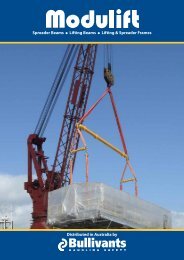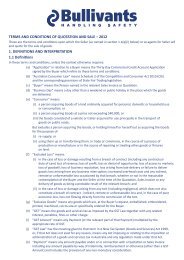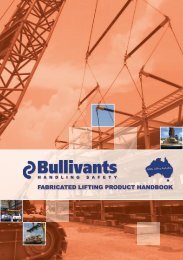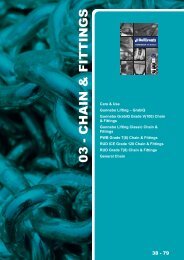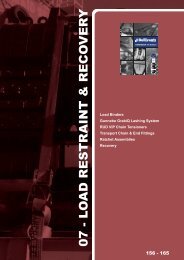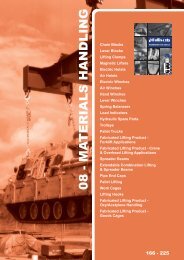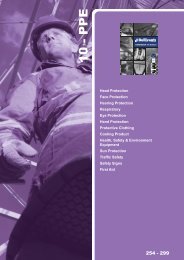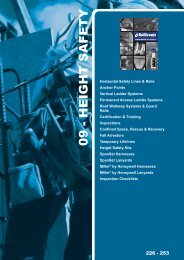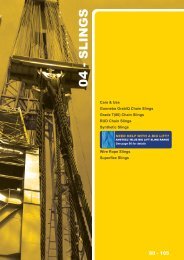STRAND
01 - wire r ope & strand - Bullivants
01 - wire r ope & strand - Bullivants
- No tags were found...
Create successful ePaper yourself
Turn your PDF publications into a flip-book with our unique Google optimized e-Paper software.
Wire Rope & Strand Characteristics<br />
Size<br />
Ropes are referred to by a diameter. The correct way to<br />
measure wire rope is shown below.<br />
Fibre Core (FC)<br />
A fibre core, generally sisal, provides a resilient foundation<br />
for the strands in the rope structure. Fibre cores are used for<br />
ropes that are not subjected to heavy loads and where fl exibility<br />
in handling is required. Fibre Cores are inadequate where wire<br />
rope is subjected to heavy loading, prolonged outdoor exposure<br />
and crushing on small drums and sheaves.<br />
Wire Rope Core (WRC)<br />
Construction<br />
The main components of wire rope are shown below.<br />
In the example above, each individual wire is arranged around<br />
a central wire to form a 7-wire strand. Six of these strands are<br />
formed around a central core to make a wire rope. The rope is<br />
specifi ed at 6 x 7 (6/1) i.e., six strands of seven wires.<br />
The actual range of wire rope Constructions is wide and varied<br />
but the number could be limited to approximately twenty-five.<br />
The size and number of wires in each strand, as well<br />
as the size and number of strands in the rope greatly affect<br />
the characteristics of the rope. In general, a large number of<br />
small-size wires and strands produce a fl exible rope with good<br />
resistance to bending fatigue. The rope Construction is also<br />
important for tensile load (static, live or shock) abrasive<br />
wear, crushing, corrosion and rotation.<br />
Cores<br />
A number of core types is available and each gives<br />
specified properties to the rope:<br />
1. Wire Strand Core (WSC) - Strand usually of the<br />
same Construction as the outer strands.<br />
2. Fibre Core (FC) - Sisal or polypropylene.<br />
3. Wire Rope Core (WRC) - a wire rope usually of<br />
6 x 7 (6/1)/1 x 7 (6/a) Construction.<br />
Wire Strand Core (WSC)<br />
Wire rope core is preferred for operating ropes in applications<br />
of high tensile stress, high compression loads on small drums<br />
and sheaves (such as on earthmoving equipment) and high<br />
operating temperatures (such as cranes handling large<br />
quantities of molten metal). A rope with WRC is approximately<br />
11% heavier and 7.5% stronger than fibre cored rope of the<br />
same size.<br />
Lay<br />
This refers to the way the wires in the strands, and the<br />
strands in the rope are formed into the completed rope.<br />
The wire strands are essentially laid up in a planetary<br />
motion with controlled twist being imparted to produce<br />
a tightly formed rope.<br />
The term Lay is used in three ways:<br />
1. To describe the direction in which the strands are laid in<br />
the rope right or left.<br />
In a Right Hand Lay strands are laid around the rope core<br />
in a clockwise direction - see illustration. In a Left Hand Lay,<br />
the strands are laid anti-clockwise - see illustrations. Steel<br />
Wire Ropes are conventionally produced Right Hand Lay<br />
unless special circumstances require Left Hand Lay.<br />
2. To describe the direction in which the wires are stranded in<br />
relation to the direction of the strands in the completed rope,<br />
e.g. Ordinary Lay or Lang’s Lay.<br />
Ordinary Lay means the wires in a strand are laid in a<br />
direction opposite to the direction in which the strands are<br />
laid in the final rope.<br />
Lang’s Lay means the wires in a strand are laid in the same<br />
direction in which the strands are laid in the fi nal rope.<br />
Lang’s Lay ropes have superior properties in resistance to<br />
wear, abrasion, fatigue and scuffi ng. This is illustrated below,<br />
where it can be seen that wear on an outer wire is distributed<br />
over a far greater area than in Ordinary Lay.<br />
3. ‘Lay’ is also a measure of the ‘pitch’ of a strand in a rope.<br />
01 - WIRE ROPE & <strong>STRAND</strong><br />
These cores are chiefly for standing ropes (guys or rigging),<br />
and offer high tensile strength and, owing to the larger wires in<br />
the core, greater resistance to corrosion.<br />
WWW.BULLIVANTS.COM 7





